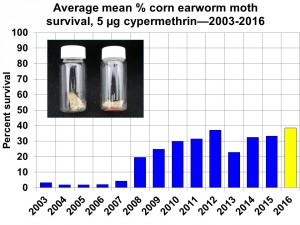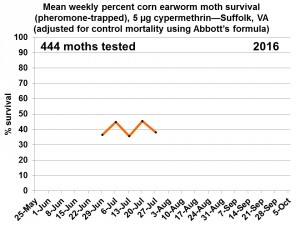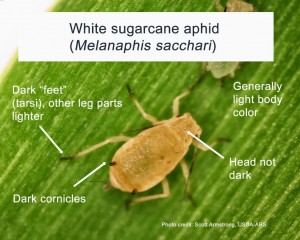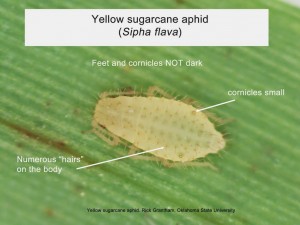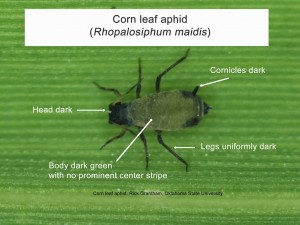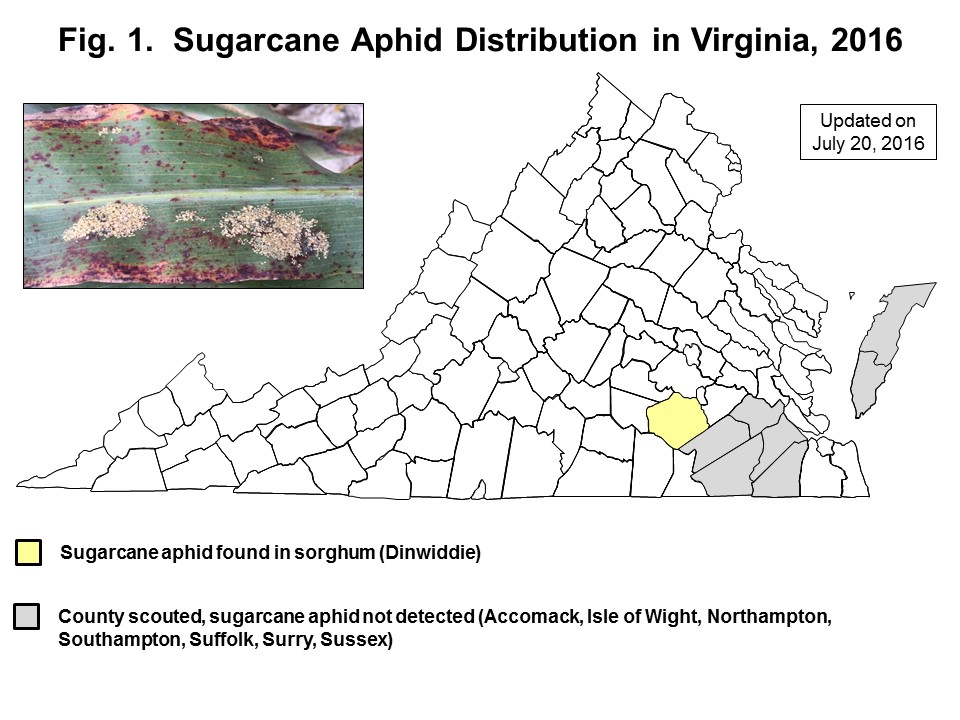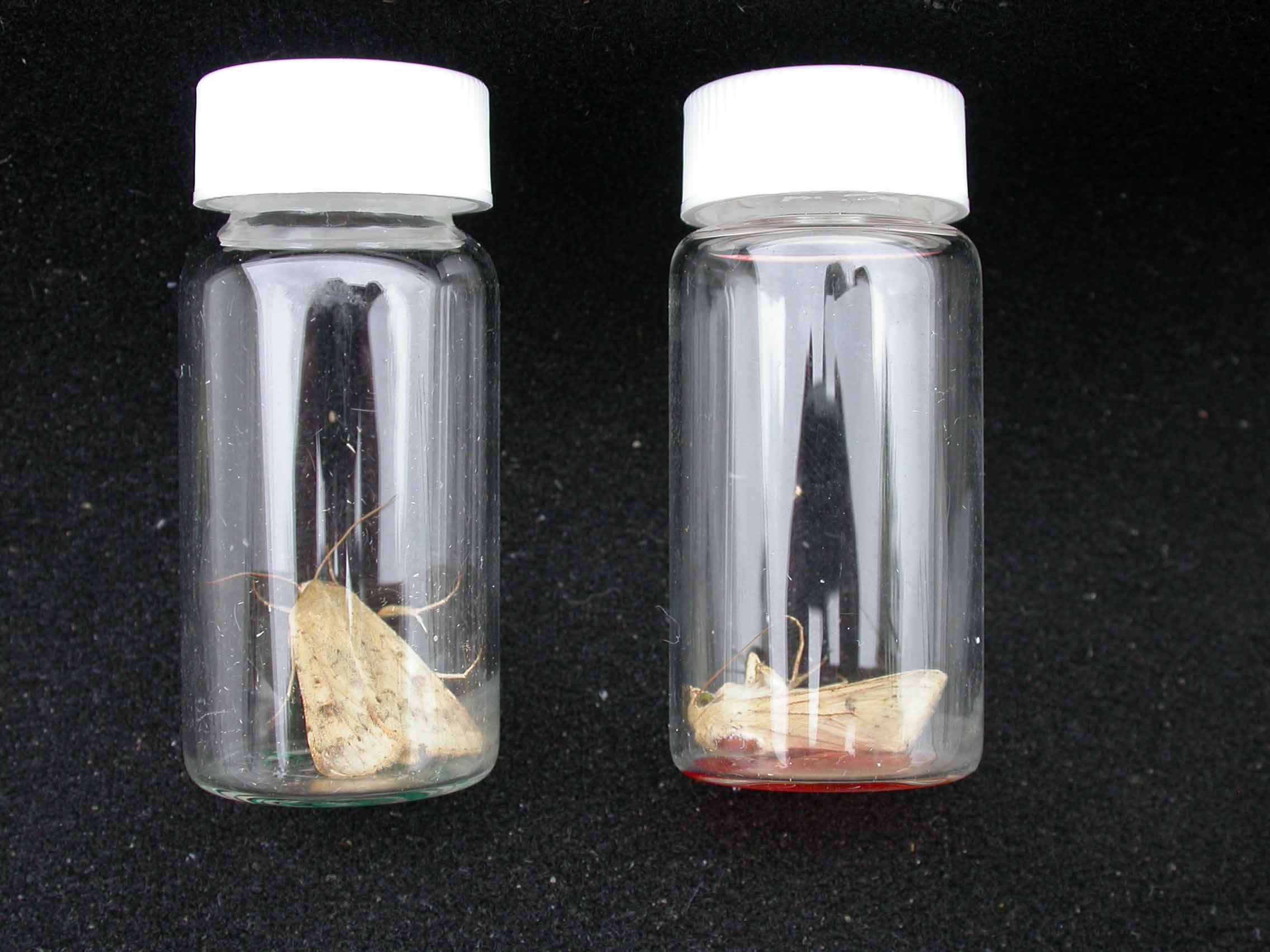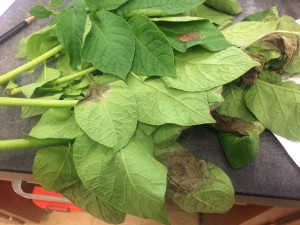As Dr. Ames Herbert mentions in his July 25, 2016 blog, we are seeing a mixture of aphids in Virginia sorghum fields this season, but we should guide control decisions based on white sugarcane aphid (Melanaphis sacchari) numbers and product recommendations (I recommend re-reading Dr. Herbert’s advisory and viewing the aphid images that he attached back on July 25). As Dr. Mike Brewer of Texas A&M mentioned to us earlier this week, corn leaf aphids (Rhopalosiphum maidis) are rarely worth concern–they are just good food for beneficial natural enemies! The Tidewater AREC Entomology crew, Virginia Cooperative Extension Agents, and other Virginia Tech faculty and staff (e.g., Dr. Joseph Oakes) have been hunting for white sugarcane aphid. We have confirmed it in Greensville (through ANR Agent Nikki Norton), Nottoway (through Jim Riddell, and ANR Agent Haley Norton), Southampton (via ANR Agent Livvy Preisser, and Mike Arrington at the Tidewater AREC), and Sussex (via Mike Arrington). You may notice that last week I reported white sugarcane aphid in Dinwiddie–that has been removed for the time being, but ANR Agent Mike Parrish is following up on a lead as I am writing this report. In some locations, we have found yellow sugarcane aphid (Sipha flava) along with the white sugarcane aphid. I have indicated on the attached map where these have been reported, and also where we have scouted sorghum, but have not found any sugarcane aphids (to date). Please keep up the scouting efforts in your sorghum fields!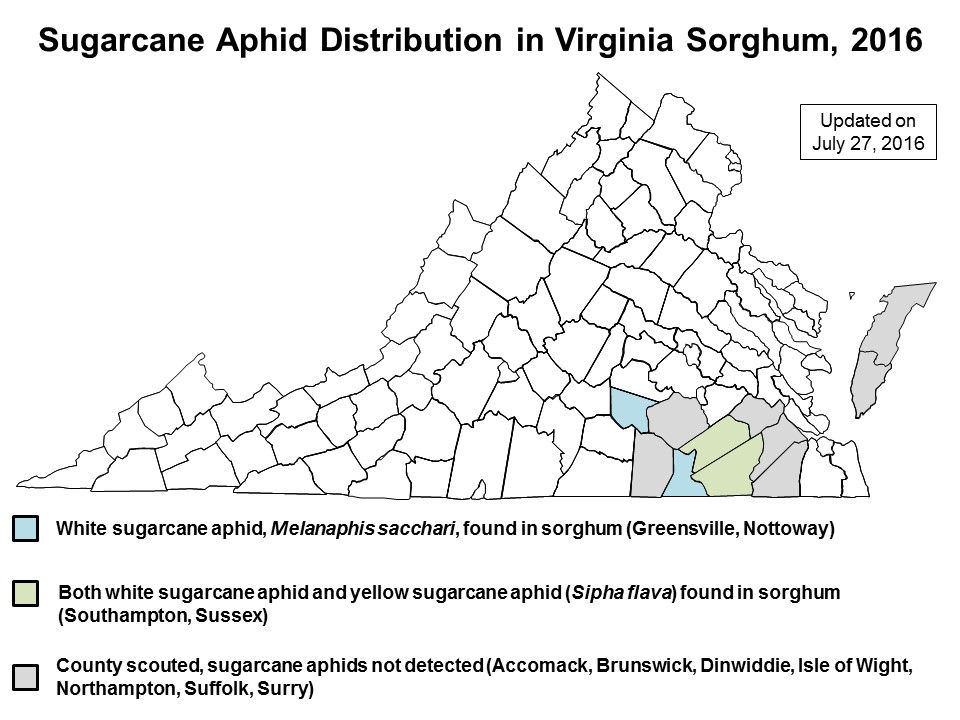
Category Archives: Pest Group
Black light trap captures for the week ending July 28, 2016
Corn earworm (bollworm) moth captures in the black light traps are beginning to pick up in Suffolk, with a slight increase in Prince George Co., and low numbers still in Warsaw and Southampton Co. Pheromone trap captures of corn earworm moths (the ones that go into our adult vial tests) really spiked this week in Suffolk; additionally, we caught nearly 100 moths in one night with 3 pheromone traps placed in a field just outside of Franklin in Southampton Co. Brown marmorated stink bug catches have increased at Warsaw, with a few reported from Prince George Co., Southampton Co. and Suffolk. Thanks to Livvy Preisser (Southampton Co. ANR Agent), Mary Beahm (Eastern Virginia AREC in Warsaw), Scott Reiter (Prince George ANR Agent), cooperating growers, and the Entomology crew at the Tidewater AREC in Suffolk for their reports this week. The attached pdf contains more details on the black light trap captures this season. BLT_28_Jul_2016
Corn earworm (bollworm) resistance monitoring update for July 28, 2016
We have vial-tested 444 moths in 2016, with a mean of 38.5% surviving the 24-hour exposure to the pyrethroid insecticide cypermethrin at 5 micrograms. These moths all were captured in Suffolk pheromone traps. While we aren’t able to say where these moths originated (they are strong fliers and could have grown up locally or far away), survival rates this high serve as a reminder that alternative (i.e., non-pyrethroid) chemistries may need consideration for corn earworm (bollworm) management, especially if heavy infestations develop. We are working with Johnny Parker and some Southampton Co. growers to trap in an area reported to have high numbers of corn earworm moths near Franklin–results of the vial testing in that location will be available next week.
Sugarcane aphid sorghum update
Brent Bean, Director of Agronomy, United Sorghum Checkoff Program, forwarded the following information on sugarcane aphid (SCA):
As many of you know, the sugarcane aphid has moved north faster than last year. We now have confirmed reports of SCA in three southern counties of Kansas. In addition, SCA is present as far north as Kentucky and Virginia. In these northern sites SCA populations for the most part are low but have approached threshold levels in Virginia. It is likely that at least low populations will be discovered in many counties within the Sorghum Belt in the coming weeks.
It is important to note that just because a few SCA are present in a field does not mean an insecticide application is or will be justified. Those who planted hybrids with some tolerance to SCA can expect the populations to build more slowly. In addition, beneficials in many areas are reported to be in high numbers, this will also help keep SCA populations in check. Although SCA was present in South Texas this year, only a portion of the fields reached threshold levels.
Something we have clearly learned the last two years is that once SCA is present in an area, scouting of fields becomes critical. Scouting should occur at least once a week once SCA has been discovered in a region, and in fields where SCA has already been detected, scouting should take place at least twice a week. Insecticide application should begin as soon as the SCA population is at threshold levels. Research has shown yields can be drastically reduced if insecticide application is delayed for several days once threshold levels are reached. States and regions vary slightly in their recommended threshold levels, but in general, an insecticide application is justified when 50 aphids per leaf are present on 25 percent of the plants. Consult your state or regional extension service for specific threshold information. We are entering a critical time in the Sorghum Belt, and SCA can potentially reach threshold levels very quickly. Diligence in scouting is an absolute must!
There are two products that should be considered if an insecticide application is warranted. These are Sivanto prime from Bayer, and Transform WG from Dow AgroSciences. Both are effective, but good coverage is critical. Most entomologists recommend 4 – 5 ounces of Sivanto Prime and 1 – 1.5 ounces of Transform WG. The lower rates are usually recommended to control SCA at or close to threshold levels. If SCA populations are way above threshold levels, then the higher rates may be justified.
If other insects such as midge or headworms are present with SCA, avoid using pyrethroids for their control. Pyrethroids can lower beneficial populations significantly and cause a rapid increase in SCA populations. In the South Plains region of Texas the ‘yellow’ sugarcane aphid is showing up in a few fields, often in the same fields with sugarcane aphid. Care should be taken in distinguishing between these two aphids.
Although sweet sorghum is a minor U.S. crop, sugarcane aphids can greatly impact yield. Sivanto prime has received a section 18 Crisis Exemption label in Mississippi, Arkansas, Tennessee and North Carolina for use on sweet sorghum in 2016.
NOTE from Ames Herbert, VT: Note that the ‘yellow’ sugar cane aphid mentioned above is a different species than SCA. Yellow sugarcane aphids are covered with small hairs and the two cornicles (pair of small upright backward-pointing tubes found on the top side of the last segment of the bodies) are small and pale (see attached image). The SCA is also called ‘white’ sugarcane aphid. It does not have hairs on the body and the two cornicles are dark (see attached image). Yellow sugarcane aphid is a known pest in Virginia of forage grasses like orchardgrass. Like Texas, we are also finding yellow sugar cane aphid mixed with SCA, and in a few fields also mixed with corn leaf aphid, another known pest of corn and sorghum. Corn leaf aphid is easy to distinguish from the other sorghum aphid species as they have a dark head and legs, a dark green body color, and dark cornicles (see attached image).
This sorghum aphid problem is new for us so we are having to make some ‘educated guesses’ about what constitutes a threat, and what the best control options might be. For now, we suggest that SCA numbers should guide control decisions, that is, abide by SCA thresholds—and stick with the products that are recommended for SCA. Avoid the use of pyrethroids since they will not be effective against SCA, and could flare secondary pests by disrupting natural enemy populations. Natural enemies including tiny aphid parasitic wasps and a variety of lady beetles can be very effective in helping reduce aphid and other pest populations, so we need to conserve them whenever possible.
Sugarcane Aphid Found in Dinwiddie County, Virginia
On July 20, 2016, Virginia Cooperative Extension Agent Mike Parrish submitted an insect sample collected from sorghum in Dinwiddie County, VA, that we confirmed as sugarcane aphid (Melanaphis sacchari). Last year, this aphid was not found in Virginia until late September (in Isle of Wight, Prince George, Southampton, Suffolk, Surry, and Sussex Counties). Infestations can stunt or even kill sorghum plants that are in the pre-head stage, and after heading the honeydew can interfere with mechanical harvest by plugging up combines.
Researchers at the Virginia Tech Tidewater and Southern Piedmont Agricultural Research and Extension Centers (Dr. Maria Balota’s crew, including Dr. Joseph Oakes; the Entomology crew; and Dr. Chris Teutsch) have been scouting sorghum for several weeks now—please see Figure 1 for our current findings.
With sugarcane aphids’ ability to spread and reproduce rapidly, sorghum scouting should begin immediately and be conducted at least weekly. Start with sorghum field edges, especially checking the underside of lower leaves. Leaves that are shiny with honeydew are a clue that aphids are present on that plant. Once aphids are found, scouting should be conducted at shorter intervals to actively monitor population growth. The economic thresholds for treatment of sugarcane aphid are provided in Table 1 and are based on North Carolina Cooperative Extension recommendations.
Table 1. Economic thresholds for treatment of sugarcane aphid in sorghum.
| Growth Stage | Threshold |
| Pre-boot | 20% infested plants with localized area of honeydew and established aphid colonies |
| Boot | 20% infested plants with localized area of honeydew and established aphid colonies |
| Flowering-milk | 30% infested plants with localized area of honeydew and established aphid colonies |
| Soft dough | 30% infested plants with localized area of honeydew and established aphid colonies |
| Dough | 30% infested plants with localized area of honeydew and established aphid colonies |
| Black layer | Heavy honeydew and established aphid colonies in head (treat to avoid problems at harvest) |
Thresholds in this table are from Sugarcane Aphid Now Present in NC-2016 https://entomology.ces.ncsu.edu/2016/07/sugarcane-aphid-now-present-in-nc-2016/ by Dr. Dominic Reisig, Associate Professor and Extension Specialist, NCSU.
In Virginia, two insecticides are recommended for sugarcane aphid control in sorghum, Sivanto (which has a FIFRA Section 2(ee) Recommendation for a reduced rate, including Virginia), and Transform WG (which is registered under a Section 18 emergency exemption for Virginia) (Table 2). Repeat applications should rotate chemistries. Good coverage of the plant with insecticides is essential for effective control. A minimum spray volume of 10 gpa is recommended. Please be sure to carefully read and follow the label.
IMPORTANT NOTE: Insecticides with pyrethroid as the active ingredient are NOT recommended for the control of sugarcane aphid. The efficacy of pyrethroid insecticides against the sugarcane aphid is low and they negatively impact the population of natural predators. This often results in a rapid increase in sugarcane aphid populations immediately following application.
Table 2. Insecticides recommended for the control of sugarcane aphid in sorghum.
| Insecticide | Active Ingredient | Application Rate | Max Annual Application Rate | Pre-Harvest Interval |
| oz/A | oz/A/year | days | ||
| Sivanto | flupyradifurone | 4-7 | 28 | 7 (forage) AND 21 (grain) |
| Transform WG | sulfoxaflor | 0.75-1.5 | 3.0 | 7 (forage) AND 14 (grain) |
For more information on the sugarcane aphid, please contact your local extension agent. Contact information can be found at http://www.ext.vt.edu/offices/index.html.
Corn earworm and brown marmorated stink bug update for July 14, 2016
Black light trap captures of corn earworm moths have been very low this past week in Suffolk (2 total moths) and Warsaw (zero moths). Captures in the Suffolk pheromone traps also dropped off this week. However, field corn and sweet corn samples suggest that we may see higher numbers of corn earworm (aka bollworm) in other crops this season.
We have started catching brown marmorated stink bug (BMSB) in the black light traps in Suffolk (5 total in the past week) and in Warsaw (4 total this week). I don’t recall ever catching that many in Suffolk before. Our soybean scouts are beginning their statewide survey for BMSB (and kudzu bug) and we will keep you informed on these pest population levels throughout the season.
Sugarcane aphid update for July 14, 2016
Our team has been scouting sorghum for sugarcane aphid in Isle of Wight, Southampton, Suffolk, and Sussex counties, but we have not detected them yet this season. They have been found in North Carolina, and with their ability to spread and reproduce rapidly, we recommend starting to scout sorghum for this pest.
There are several aphid species that can be found in sorghum, but sugarcane aphids are cream yellow in color with two, short dark cornicles (“tailpipes”) on their hind end. Start weekly scouting at the field edges, especially checking the underside of lower leaves. Once insects are found, scouting should be conducted at shorter intervals to actively monitor population growth. Dr. Dominic Reisig, Extension Entomologist at North Carolina State University, provides these thresholds for sugarcane aphid.
When pesticides are needed, we recommend Sivanto (which has a FIFRA Section 2(ee) Recommendation for a reduced rate of 4-7 oz/A, including Virginia), or Transform WG (which is registered under a Section 18 emergency exemption for Virginia at a rate of 0.75-1.5 oz/A). Good coverage is essential. Please refer to (and follow!) the labels for more details, including the maximum amount that can be applied annually, pre-harvest intervals, etc. Repeat applications, when needed, should rotate active ingredients. Pyrethroids are not recommended.
Corn earworm update for July 7, 2016
Our black light trap at the Tidewater AREC in Suffolk is just now beginning to catch low numbers of corn earworm moths–we had 4 total this past week. The Eastern Virginia AREC in Warsaw is not catching them yet.
We have caught some corn earworm moths in our pheromone traps in Suffolk (pheromone traps often out-perform black light traps early in the season for this species). We have conducted vial tests on 160 moths since late June, and have seen quite high levels of survival for the start of the season (an overall average of 38.6% of moths surviving the vial test). As in the past, we are exposing these moths for 24 hours to vials treated with a standard pyrethroid insecticide, cypermethrin, at 5 micrograms per vial. For comparison, in 2015 we had about 21% survival at this time of the season, with a peak survival rate of 51% occurring in late August. We will continue to provide updates on this issue.
LATE BLIGHT IN VIRGINIA
Late blight was found in Accomack County, VA yesterday on potato. Growers on the Eastern Shore and other areas of the Commonwealth should scout their fields and take preventative measures. Please let us know if you have any questions. For more information on this potentially devastating disease of potato and tomato visit: https://pubs.ext.vt.edu/ANR/ANR-6/ANR-6_pdf.pdf
Stink bugs already in small grain and field corn
Our overall mild winter and wet spring are the kinds of conditions that favor survivorship and early development of stink bug populations. Because of these conditions, this could be a summer when we see higher than normal stink bug infestations in a lot of crops including field corn, cotton and soybean. Brown stink bugs are already being found in small grain fields and areas of North Carolina are reporting pretty heavy stink bug pressure on seedling field corn. See this article by Dr. Dominic Reisig at the NCSU station on Plymouth for details https://entomology.ces.ncsu.edu/2016/05/how-to-avoid-a-stink-bug-disaster-in-corn-2/
We need to be thinking ‘stink bugs’ this summer and aligning our field scouting, sampling and threshold efforts in that direction as the summer progresses—and that applies to cotton and soybean fields as they mature.

